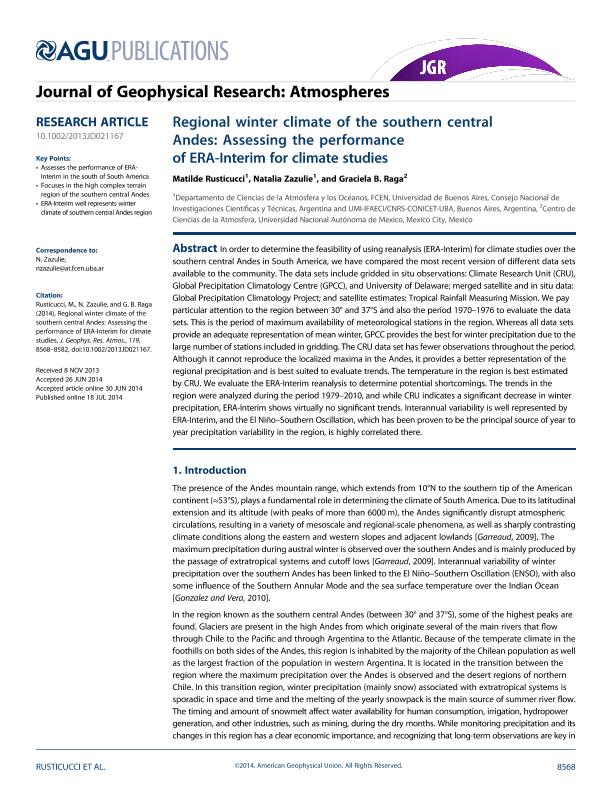Mostrar el registro sencillo del ítem
dc.contributor.author
Rusticucci, Matilde Monica

dc.contributor.author
Zazulie, Natalia

dc.contributor.author
Raga, Graciela B.
dc.date.available
2020-08-04T19:41:25Z
dc.date.issued
2014-07
dc.identifier.citation
Rusticucci, Matilde Monica; Zazulie, Natalia; Raga, Graciela B.; Regional winter climate of the southern central Andes: Assessing the performance of ERA-Interim for climate studies; American Geophysical Union; Journal of Geophysical Research; 119; 7-2014; 8568-8582
dc.identifier.issn
0148-0227
dc.identifier.uri
http://hdl.handle.net/11336/110838
dc.description.abstract
In order to determine the feasibility of using reanalysis (ERA‐Interim) for climate studies over the southern central Andes in South America, we have compared the most recent version of different data sets available to the community. The data sets include gridded in situ observations: Climate Research Unit (CRU), Global Precipitation Climatology Centre (GPCC), and University of Delaware; merged satellite and in situ data: Global Precipitation Climatology Project; and satellite estimates: Tropical Rainfall Measuring Mission. We pay particular attention to the region between 30° and 37°S and also the period 1970–1976 to evaluate the data sets. This is the period of maximum availability of meteorological stations in the region. Whereas all data sets provide an adequate representation of mean winter, GPCC provides the best for winter precipitation due to the large number of stations included in gridding. The CRU data set has fewer observations throughout the period. Although it cannot reproduce the localized maxima in the Andes, it provides a better representation of the regional precipitation and is best suited to evaluate trends. The temperature in the region is best estimated by CRU. We evaluate the ERA‐Interim reanalysis to determine potential shortcomings. The trends in the region were analyzed during the period 1979–2010, and while CRU indicates a significant decrease in winter precipitation, ERA‐Interim shows virtually no significant trends. Interannual variability is well represented by ERA‐Interim, and the El Niño–Southern Oscillation, which has been proven to be the principal source of year to year precipitation variability in the region, is highly correlated there.
dc.format
application/pdf
dc.language.iso
eng
dc.publisher
American Geophysical Union

dc.rights
info:eu-repo/semantics/openAccess
dc.rights.uri
https://creativecommons.org/licenses/by-nc-sa/2.5/ar/
dc.subject
Southern Cerntral Andes
dc.subject
Climate
dc.subject
ERA-Interim
dc.subject.classification
Meteorología y Ciencias Atmosféricas

dc.subject.classification
Ciencias de la Tierra y relacionadas con el Medio Ambiente

dc.subject.classification
CIENCIAS NATURALES Y EXACTAS

dc.title
Regional winter climate of the southern central Andes: Assessing the performance of ERA-Interim for climate studies
dc.type
info:eu-repo/semantics/article
dc.type
info:ar-repo/semantics/artículo
dc.type
info:eu-repo/semantics/publishedVersion
dc.date.updated
2020-05-11T16:39:43Z
dc.journal.volume
119
dc.journal.pagination
8568-8582
dc.journal.pais
Estados Unidos

dc.description.fil
Fil: Rusticucci, Matilde Monica. Consejo Nacional de Investigaciones Científicas y Técnicas; Argentina. Universidad de Buenos Aires. Facultad de Ciencias Exactas y Naturales. Departamento de Ciencias de la Atmósfera y los Océanos; Argentina
dc.description.fil
Fil: Zazulie, Natalia. Universidad de Buenos Aires. Facultad de Ciencias Exactas y Naturales. Departamento de Ciencias de la Atmósfera y los Océanos; Argentina. Consejo Nacional de Investigaciones Científicas y Técnicas; Argentina
dc.description.fil
Fil: Raga, Graciela B.. Universidad Nacional Autónoma de México; México
dc.journal.title
Journal of Geophysical Research

dc.relation.alternativeid
info:eu-repo/semantics/altIdentifier/doi/http://dx.doi.org/10.1002/2013JD021167
dc.relation.alternativeid
info:eu-repo/semantics/altIdentifier/url/https://agupubs.onlinelibrary.wiley.com/doi/full/10.1002/2013JD021167
Archivos asociados
